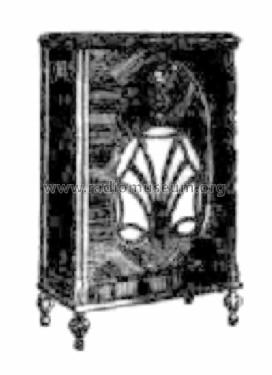Radiola Ninety Ch= C66A Console
Amalgamated Wireless (Australasia) Ltd. (AWA); Sydney
- Pays
- Australie
- Fabricant / Marque
- Amalgamated Wireless (Australasia) Ltd. (AWA); Sydney
- Année
- 1930
- Catégorie
- Radio - ou tuner d'après la guerre 1939-45
- Radiomuseum.org ID
- 164059
- No. de tubes
- 7
- Principe général
- Récepteur TRF - sans réaction (pas régénératif); 2 Etage(s) BF; Tube à grille écran 1926-1935.
- Gammes d'ondes
- PO uniquement
- Tension / type courant
- Alimentation Courant Alternatif (CA) / 190-270 Volt
- Haut-parleur
- HP dynamique à électro-aimant (électrodynamique)
- Matière
- Boitier en bois
- De Radiomuseum.org
- Modèle: Radiola Ninety Ch= C66A [Console] - Amalgamated Wireless
- Forme
- Console avec pieds bas < 50% de la hauteur
- Remarques
-
7 Valve, AC powered, screen grid, TRF Receiver with Linear Power Detection and two, transformer coupled, audio stages. The volume control on this Model and Duforte Ninety was a handheld, wired remote control type. It comprised of a handheld potentiometer mounted in a cylindrical case with a Bakelite knob plugged into the terminals in an ident on the left hand side of the cabinet and was connected by a 3 core, screened cable. When not in use the unit hooks onto the side of the cabinet
Chassis:
The chassis was available in two versions according to the “Complete List Radiola receivers 1925-1938”, this Console model, C62A and the C62 Table and it is not clear of any differences between the two chassis. Both versions had a Local-Distance switch in the aerial circuit. According to advertising both Table and Console used the remote volume control.Cabinet:
Console cabinet, Maple finish with an ident on the left hand side were the remote volume control plugs in.
- Prix de mise sur le marché
- 74.00 Aus£
- Schémathèque (1)
- - - Manufacturers Literature (AWA Service Instruction 1930)
- Auteur
- Modèle crée par Stuart Irwin. Voir les propositions de modification pour les contributeurs supplémentaires.
- D'autres Modèles
-
Vous pourrez trouver sous ce lien 1430 modèles d'appareils, 873 avec des images et 463 avec des schémas.
Tous les appareils de Amalgamated Wireless (Australasia) Ltd. (AWA); Sydney
